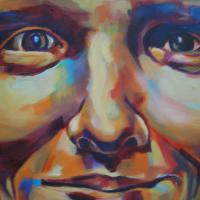The human subject captivates me. For my Thesis and continuing body of work, I am focusing on and using non-traditional portraiture to explore my cultural anger. By non-traditional portraiture, I mean that I have painted my subjects heads as vibrantly buoyant personalities on the canvas; however, the heads are politely severed from their bodies. Red is vibrant and potent, thus I have painted red as a unifying background, which serves as a “green screen” that receives and contains the viewers’ projections.
My thesis consists of 15 portraits varying in size, with heads ranging from actual size to that of an enormous ratio of increase. My originating point of interest for The Congregation was the 2011 media blitz of the image of Jared Loughner. While he certainly seems to be guilty of a horrific crime, his isolated image made me think of him as an unloved and suddenly despised person. Exploring details related to Loughner’s past deepened my sadness for a boy clearly disturbed, who failed at every turn. Furthering this thought, I questioned how society and media portray people to be loved, revered, remembered, or despised. Why do we praise one person, a peace activist like John Lennon or Cindy Sheehan and vilify another, like the Manson family member Mary Brenner? On the surface the differences are clear, but if we can think past the point of easy labels, I propose that we might be able to trade in our hysterical judgments for rational thought.
Most Americans understand the court concept that a person is innocent until proven guilty. Likewise, could then each person be loveable until proven unlovable? For my wall of portraits, I selected people who are innocent and guilty, loved and unloved, people with rational minds and people with mental disorders, people who society elevated or people who were cast out and vilified. The salon style installation of these disembodied heads has been important from the inception of the project. I feel constantly overwhelmed by the pressure to judge and label and box in and cast out. I feel the effect of media creeping into every aspect of my life. I present a wall of images to simulate the onslaught of imagery, the onslaught of our digitized surrealistic present, and re-familiarize with the historic (space-maximizing) portrait exhibition format found in museums, such as the Corcoran Gallery of Art.
Who are the people that decide if other people live or die? I thought of people who are selected to die. How are they remembered? Are we the sum of our achievements and actions? Are we the sum of how much we have been loved? At what point does subtraction begin? Why are people entertained and drawn to others misfortunes? Why does violence sell so well? If the crime is not remembered, and you see a portrait of a victim, do you project more empathy or curiosity? How would you approach a picture of an unknown person who committed a crime? I selected 15 people and will present them to the audience for consideration. I hope and encourage viewers to think past the conclusion they might normally be quick to make.



